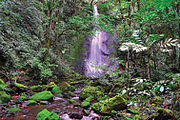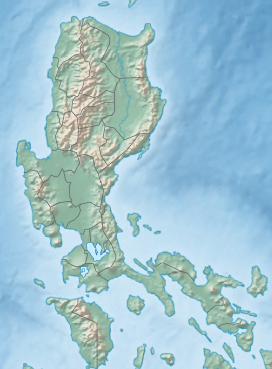Cagua Volcano
| Cagua Volcano | |
|---|---|
| Kagwa Volcano | |
 Volcanic vent on the floor of the Cagua crater | |
| Highest point | |
| Elevation | 1,133 m (3,717 ft)[1] |
| Listing | Active volcanoes in the Philippines |
| Coordinates | 18°13′18″N 122°07′24″E / 18.22167°N 122.12333°E |
| Geography | |
 | |
| Country | Philippines |
| Region | Cagayan Valley |
| Province | Cagayan |
| City/municipality | Gonzaga |
| Parent range | Sierra Madre |
| Geology | |
| Rock age | Pleistocene |
| Mountain type | Stratovolcano |
| Volcanic arc | Babuyan (Bashi) Segment of Luzon-Taiwan Arc |
| Last eruption | October 1907 |
Cagua Volcano is a stratovolcano located in the Philippine province of Cagayan. It is one of the active volcanoes in the Philippines and has erupted twice in recorded history. Its last eruption was in 1907.
Geography
Cagua is one of the active volcanoes in the Philippines located in the province of Cagayan in the Cagayan Valley Region of northern Luzon in the northernmost part of the Sierra Madre mountain range.[2] The mountain is approximately 12 kilometres (7.5 mi) south of Gonzaga, Cagayan and 14 kilometres (8.7 mi) south of Port Irene in Santa Ana, Cagayan.[3]
Geology

Activity of the early Pleistocene erupted basaltic andesite or effusive basalt. The volcano was covered by enormous lava flows from 600,000 to 300,000 years ago. It has seen activity ranging from phreatic eruptions to ash flows. The volcano is topped by a 1.5-kilometer (1 mi) wide crater marked by sharp and precipitous walls.
It has six hot springs. Maasok near the crater; Marafil in the northwest; Manaring, 5 kilometres (3.1 mi) north-northeast; San Jose, 10 km (6.2 mi) north-northeast; Kabinlangan, 3 km (1.9 mi) northwest and Paminta, 2 km (1.2 mi) north-northwest.[3]
Eruptive activity
Two historical eruptions have taken place at the volcano. Activity in 1860 was a largely phreatic eruption though it was possibly followed by a pyroclastic flow. Renewed eruptions took place in October 1907 .[3]
See also
References
- ^ "Cagua". Global Volcanism Program. Smithsonian Institution.
- ^ "Mt. Cagua Peak & Crater - Gonzaga, Cagayan". Archived from the original on December 5, 2014. Retrieved August 19, 2013.
- ^ a b c "Cagua". Philippine Institute of Volcanology and Seismology. Retrieved on September 26, 2014.
External links
- "Cagua Volcano Page". Philippine Institute of Volcanology and Seismology (PHIVOLCS). Archived from the original on January 17, 2010. Retrieved November 14, 2008.


